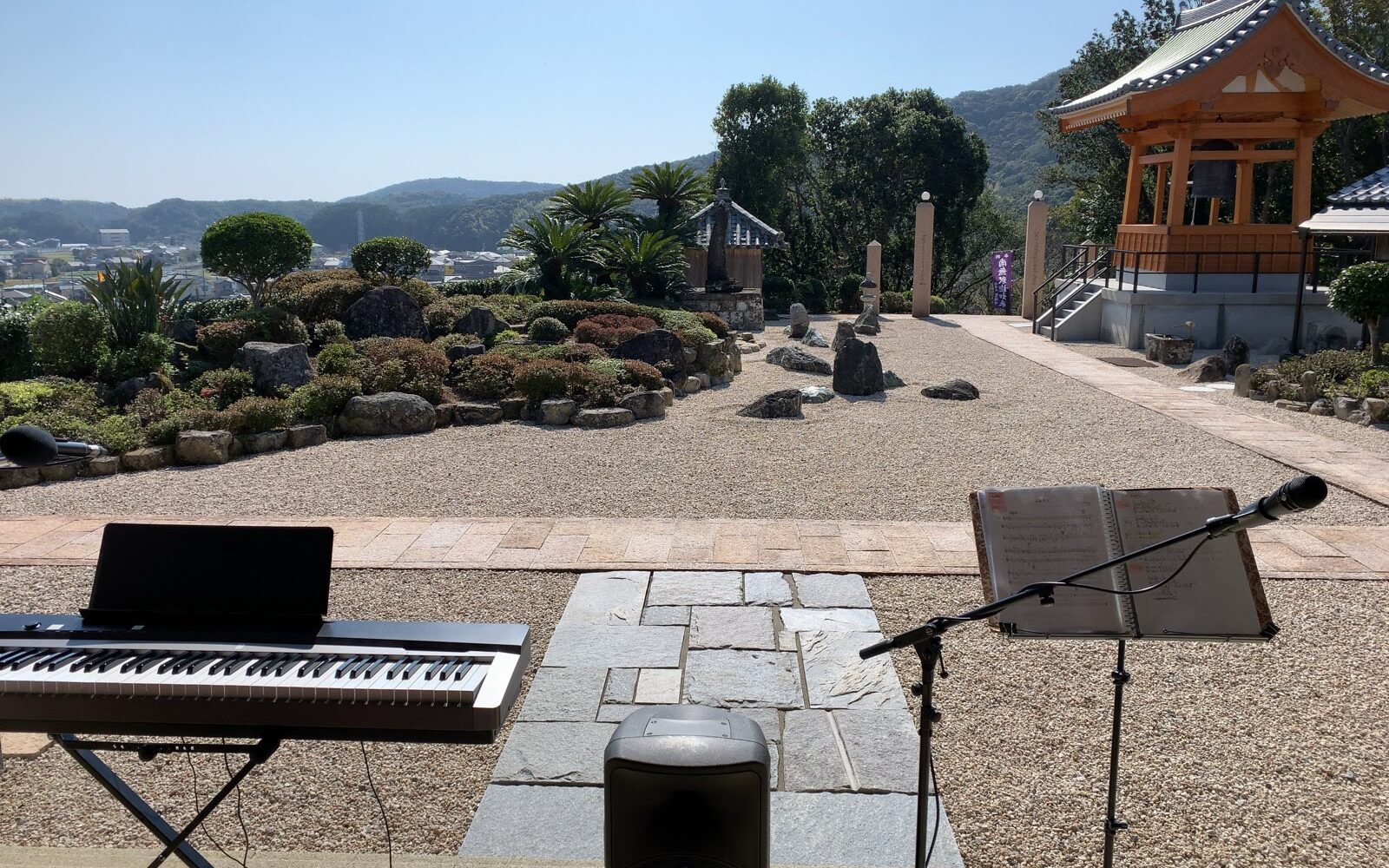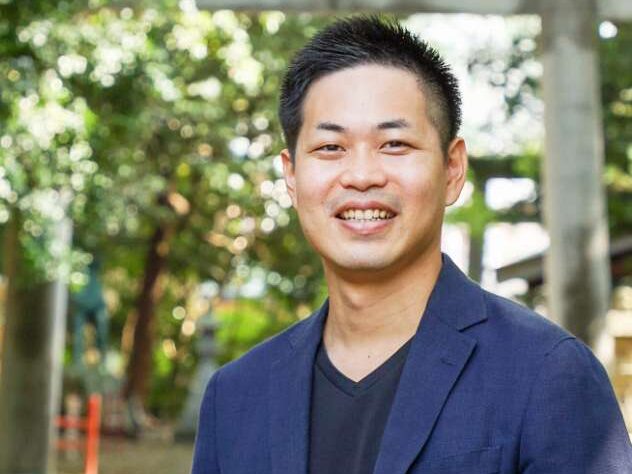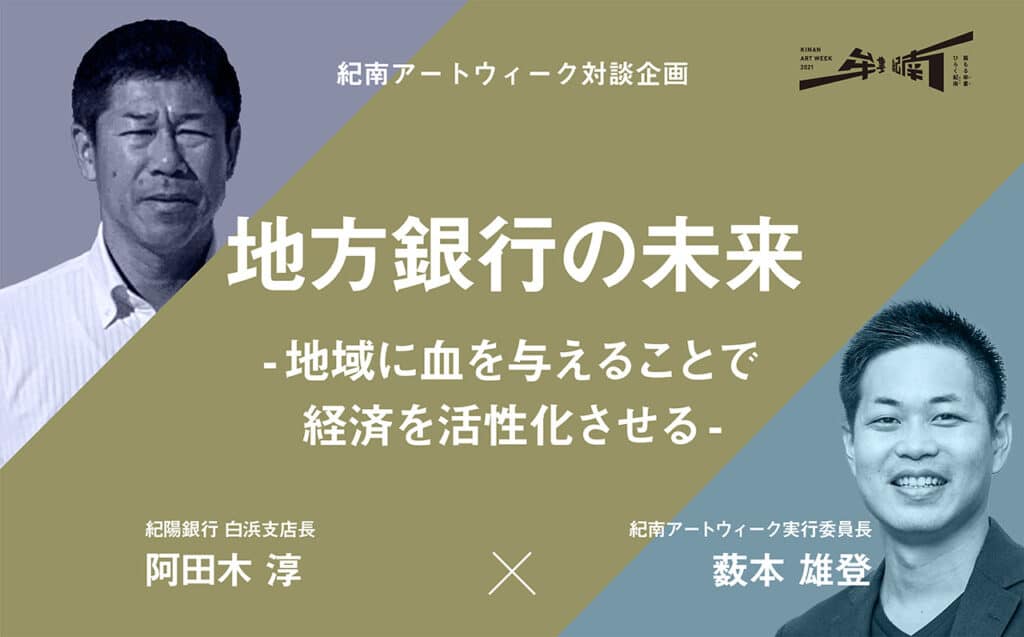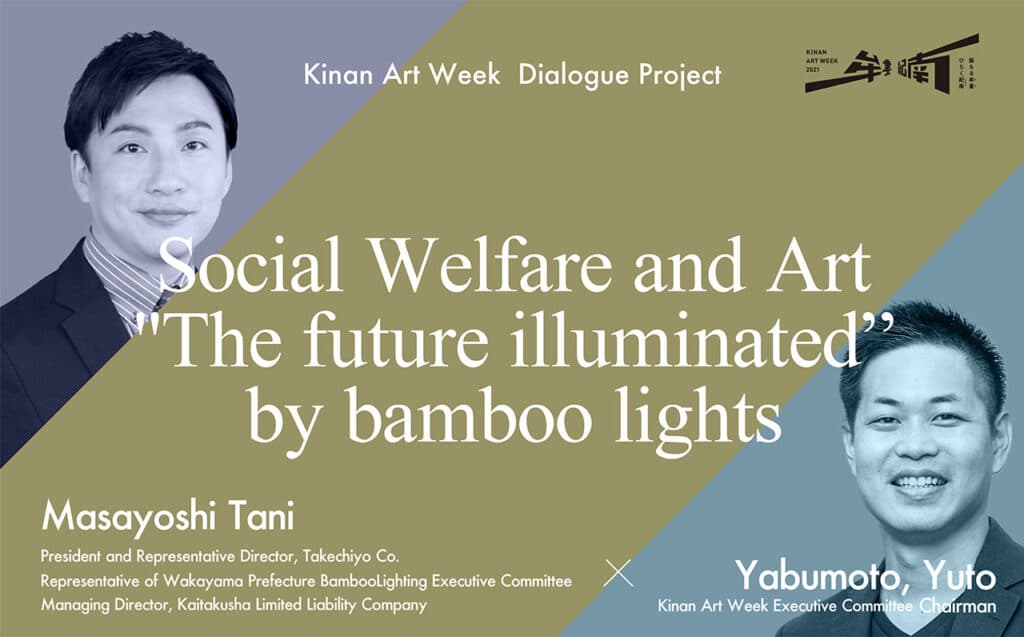
Kinan for the senses – temples and music
<Our guest this time>
Chief priest of Shofukuji Temple in Nanki-Shirahama Kengo Sekimori
He uses music to make the temple more accessible to the public.
Shofukuji’s Youtube channel: https://www.youtube.com/user/Shofukuji
He distributes Zen Buddhism teachings, healing music and Goeika(Japanese poems) on this channel to help you find peace of mind.
http://shofukuji.net/
<Interviewer>

Yuto Yabumoto
Kinan Art Week Executive Committee Chair
<Editing>
Kinan Editor by TETAU
https://good.tetau.jp/
Kinan for the senses – temples and music
<Table of Contents>
1.Introduction of Mr.Sekimori and the origins of Shofukuji Templei
2.”When faced with a problem, change. When you change, the problem will pass” “
3.Temples and music
4.Kinan, a place fit for human life
5.Art in everyday life
1. Introduction of Mr. Sekimori and the origins of Shofukuji Temple
Yabumoto:
Thank you very much for your time.
I have been watching Mr Sekimori’s webcasts with great interest.
Today, I would like to ask you to tell us about your activities as a priest, and also about your own philosophy.
We look forward to working with you.
Mr Sekimori:
I look forward to working with you as well.
My name is Kengo Sekimori and I am the abbot of Shofukujii Temple in Shirahama Town.
I was born in 1972 in Shirahama and attended Nishitonda Elementary School and Tonda Junior High School. I went to high school at Chiben Gakuen Wakayama High School and then Waseda University School of Law.
In hindsight, living in Tokyo for four years gave me the opportunity to think about “the places where people live”.
After graduating from university, I spent four years at the Shōfukuji training centre in Kobe, Japan, where I learned practical training such as zazen(sitting meditation), asking for alms, cleaning, and answering Zen questions.
Afterwards, I studied at the graduate school of Hanazono University, a university institution of Shumon(religious denomination) in Kyoto, Japan. After studying for 5 years in the master’s and doctoral programs, I obtained a doctorate in literature (Buddhist studies). I returned to Shirahama when I was about 30 years old, and at the age of 33 I succeeded my father as chief priest of Shofukuji Temple.
Yabumoto:
When did you decide that you wanted to become a monk?
Mr Sekimori:
My great-grandfather, grandfather and father were the abbots of Shofukuji Temple for generations. As the eldest son of the temple, I had been wearing a robe and following my father to the temple since I could remember, so naturally I wanted to become a monk in the future.
However, when I was an adolescent in junior high school, something about that must have embarrassed me. A friend told me that at the time I was adamant that I would never become a monk. I don’t remember much about it. (laughs). After I turned 20, when I thought about my life, I knew that there was no other choice but to become a monk. As soon as I graduated, I went to a training centre in Kobe.
I think I admired my father’s example and I wanted to be able to give something back to the people of Kinan, who had taken care of me since I was a child.
Yabumoto:
Can I ask you about the background to the opening of Shofukuji Temple?
Mr Sekimori:
Shofukuji Temple is a Zen temple belonging to the Zen sect (Rinzai sect). About 400 years ago, in the early Kan’ei period of the Edo period, a young monk who was travelling around the country stopped and built a hermitage in Katada. It is said that he decided that this was the place where he would train and spread his knowledge.
The villagers, who were initially indifferent, were struck by the pious manner in which he preached the Buddha’s infinite teachings. The first head priest of Shofukuji, Icchou Shoten, was loved as a “great and kind monk”. The teachings have been handed down from generation to generation and I am the 15th abbot of the temple.
Yabumoto:
So that’s how it came about. Mr. Sekimori, may I ask you about your own background?
Mr Sekimori:
For 20 years I was a part-time lecturer at Hanazono University and for four years I was a member of the Wakayama Prefectural Board of Education, while working as a priest in Shirahama.
I am currently spending a lot of time maintaining the grounds of Shofukuji Temple so that visitors to the temple can feel refreshed and as if they have arrived in the Pure Land of Ultimate Bliss. Because we are on top of a mountain, the site is very large, from the car approach to the temple grounds. Every day I make use of mowers, blowers and chainsaws to keep the landscape in order.
2. “When faced with a problem, change. When you change, the problem will pass”
Yabumoto:
What are some of the challenges you see for temples in terms of both education and temples?
Mr Sekimori:
I feel that the problem is that there is beginning to be a gap between the temple and society. In the past, people believed that the sutras themselves had power and that just listening to them would bring benefits and merit, even if you didn’t understand what they meant.
That is what sutras are supposed to be, but I think we are living in an age where we feel that this is not enough. If we don’t have other things to connect the temple with society, such as funerals and memorial services, which are based on ancestor worship, then I feel that the gap between the temple and society will become even greater.
Yabumoto:
So that’s what you’re doing now.
Mr Sekimori:
Yes, that’s right. I give “musical Dharma talks”, incorporating musical performances in between talks.
It all started when the director of a welfare facility for the elderly asked me to come and give a talk. I’m not very good at public speaking, not to mention I would be speaking to senior citizens. I had no idea what to say, so I decided to sing. I used to play the guitar when I was a student, so I spent half the time talking and the other half playing songs such as “Sakura”, “Akatonbo” and “Furusato” on the guitar and having the audience sing along.
In the end, I had mixed feelings though, because I was praised only for my singing. (laughs)
I thought, “If the seniors are happy that I came, then that’s all that matters”. Then I started to sing. Before the Corona pandemic, I used to go to about 40 places a year to meet people in Kinan.
Yabumoto:
You’ve been to so many places!
Mr Sekimori:
However, these events have almost disappeared. I could no longer hold zazen sessions in the main hall with the local community. I thought about what I could do, and came up with the idea of transmitting the thoughts of a monk on YouTube. This is how the “Nanki-Shirahama Shofukuji Channel “*1 was born. Quoting Zen words and classics, I offer tips on how to overcome adversity and play calming music.
I have also switched our zazen sessions to online. I’ve been doing two zazen sessions a month on Zoom, but I’ve decided to do one of them on YouTube. I had my first YouTube session just the other day, and 500 people attended, including those who missed it. This is unthinkable for a zazen session in the main hall.
I hope to continue to work in a way that is in tune with the times, remembering that “When faced with a problem, change. When you change, the problem will pass “*2.
※1 The Nanki-Shirahama-Shofukuji channel currently has 1,900 subscribers.
Video of the complete collection of the 33 holy poems of the Western Province: https://www.youtube.com/watch?v=7pkd84WT4LU
※2 A phrase from the I Ching, one of the Confucian scriptures. It means that when things reach a dead end, there is always a change and a new development begins.
3. Temples and music
Yabumoto:
I found out that you are a musician through Youtube. I would like to hear about the relationship between the temple, music and sutras.
Mr Sekimori:
The sutras were not originally written on paper. It is said that after the Buddha’s death, his disciples gathered together and passed on the sutras in words, saying “this is what the Buddha said at that time” and “this is what we heard”. The melody and rhythm were added for the sake of transmission to future generations.
There is a difference between the written sutra and the spoken sutra. Brain science also says that the part of the brain that understands scripture is different from the part that understands song. A care worker said, “Songs touch the heart not theoretically, but emotionally. To understand something written, you need to convert it in your brain, but ‘sound’ resonates directly in your heart.
It is said that Hakuin Zenji, a famous monk of the Edo period, attained enlightenment by hearing the sound of a distant temple bell. In this sense, too, there is a close relationship between sutras and music.
Yabumoto:
Sounds are intuitive, aren’t they? Sutra, too, could be defined not as a theory, but as something necessary for human life, even if we don’t quite understand its meaning.
Mr Sekimori:
Singing has been a means of expressing emotions since before the development of language. And I think it had a religious element to it. Singing was the resonance of life in tune with the rhythms of nature. I believe that we have been singing or listening to songs for a long time to find our inner stability.
The aim of Zen Buddhism is “to touch the hearts of those who are living in the present moment, to bring peace to their minds”. In the same way that I value the sutras, I also value music.
You may be surprised to learn that monks play music. In fact, it is nothing new. As far back as the earliest times, biwa priest used to play the biwa to explain the truth of the impermanence of all things. He said that the world is fleeting and impermanent. I would like to replace the biwa with a guitar and tell people that although this world is impermanent, it is wonderful to live. I want to share the joy of life with everyone.
The essence of the Heart Sutra is the last part, “Gyate-gyate, hara-gyate harasou-gyate Bojisowaka” . Do you know what it means?
Our great predecessor, the Venerable Master Yamada Mumon*3, wrote in this part
It’s translated as:
“Gyate-gyate” = I’m here, I’m here.
“Hara-gyate” = I have arrived at the other shore.
“Harasou-grate” = We all arrived at the other shore together.
“Bojisowaka” = This was the Pure Land!
Heaven and paradise were not somewhere far away, they were actually right here! We have all arrived at Paradise together, even though we are in this world! That’s what it means. The Heart Sutra is not a sutra of mourning for the deceased, but a song of joy, a song of gladness.
※3 Yamada Mumon
He is a monk of the Rinzai sect. His book “Looking at oneself” is a good first book for understanding Zen.
This book is recommended by Mr Sekimori.
4. Kinan, a place suitable for human life
Yabumoto:
What kind of place is Kinan for you, Sekimori?
Mr Sekimori:
I have lived in Wakayama City, Tokyo, Kobe and Kyoto. Compared to those places, I think Kinan is a “good place for human beings to live”. With the advent of the information society, AI and IoT, I believe that Kinan will be able to enjoy more and more of the advantages that cities have to offer.
On the other hand , the merits of Kinan be a ‘“good place for human beings to live” – are not available in the city. From now on, I believe that the advantages of Kinan will be highlighted.
Yabumoto:
What, exactly, makes a place “good for human beings to live”?
Mr Sekimori:
In my experience, when I was living in a big city, I was very tired in the evening. Probably because in the city there is too much information coming in through the five senses, so you get mentally tired. In Kinan, on the other hand, the information coming in from the five senses is calmer, so I think I can stay healthy and sound in body and mind. In this sense, I feel that Kinan is a good place for human beings to live.
Yabumoto:
The values and functions of temples and music are similar to those of Kinan.
Mr Sekimori:
In that respect, I think it’s the same.
There is a lot of talk in the education world today about “moving towards Society 5.0 – changing society, changing learning”. “Society 5.0” is the fifth society. It means that in the near future, society will change and learning will change. That’s why we have to prepare for it now, they say.
Society 1.0 = hunting society 200,000 years ago
Society 2.0 = agrarian society 10,000 years ago
Society 3.0 = industrial society 200 years ago
Society 4.0 = Information Society 25 years ago
Society 5.0 = AI and IoT (Artificial Intelligence and Internet of Things) society
What do you think of this?
Societies change too fast, don’t they? It took 190,000 years for us to move from a hunting society to an agricultural society. The information society started only recently, and now we are already moving to the next society. It’s hard for our minds to keep up with this speed. So, I think it is important to slow down.
A psychiatrist once said: “The richness of time spent slowly is probably the most abundant thing you can feel. It’s important to slow down, to let time flow in a wide range.”
The slowest time of the day is actually the time when you can see further and expand your horizons more than when you’re working your head off trying to be efficient.
I think that temples and music serve this function. Just like the value and function of Kinan.
5. Art in everyday life
Mr Sekimori:
It is for this reason that I recommend zazen now. Interestingly, Kinan Art Week advocates the definition that “the concepts of ‘Komoru’ (seclusion) and ‘hiraku’ (openness) have an equal relationship”, and I think this is also true of zazen.
In Zazen, the key is to “tune the body, tune the breath, tune the mind”. This is the direction of “Komoru” in oneself. As you look at yourself, the boundary between you and the world disappears, and you reach the point where you and the world are one. Then the world opens up on a very large scale, where everything you see and hear is you. It seems like you are hiding, but actually you are opening up. I think that is what zazen is all about.
There is no need to go global so quickly . I agree with the idea that it is not necessary to aim for globalization, that it is okay to be secluded, and that we should close ourselves before we can open ourselves up, and that it is only when we close ourselves and look deeply again that we can connect with the global world. I hope that people will use temples and music to “close” and “open up”.
Yabumoto:
What kind of activities, ideas and philosophies do you think Kinan needs to continue to be in the future?
Mr Sekimori:.
Kinan, as I mentioned earlier, is a very wonderful place. For the future of Kinan, I think it’s important for those of us who live here to become aware of the charm of Kinan. I think the Kinan Art Week is doing a lot to raise awareness of this.
Yabumoto:
I’m glad you said that.
Finally, do you have any expectations for Kinan Art Week?
Mr Sekimori:
When you saw me chanting the Heart Sutra loudly while ringing the coma bell, you said “This is art”. That’s when I had an epiphany. I think there are many people in Kinan who, like me, think that ‘art’ is a world that has nothing to do with them. This is not the case. Our daily life in Kinan, our daily work itself is “art”. I hope that you will lead us all to realise this, and to take pride in living in the midst of our wonderful natural and cultural heritage.
Yabumoto:
During Art Week, we hope to hold events that combine Kinan, temples and music. Thank you very much for your valuable talk today.


